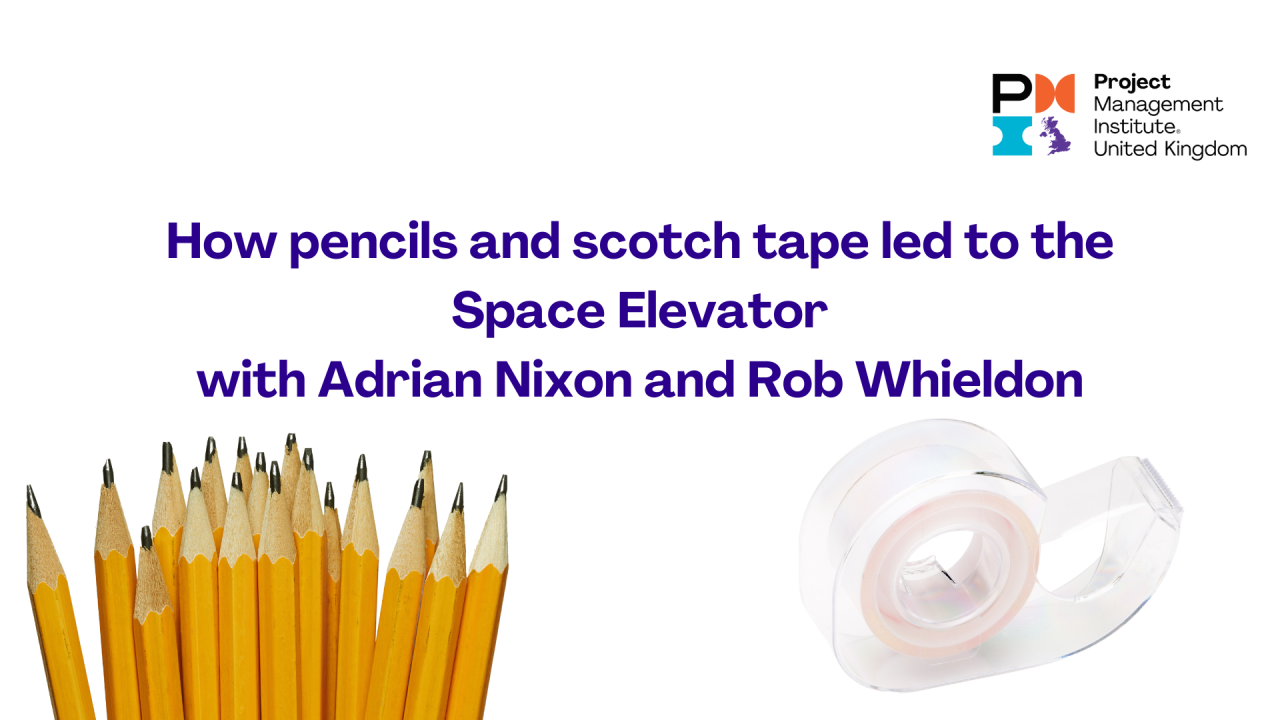Adrian Nixon and Rob Whieldon of Nixene Publishing gave a fascinating presentation to the North Scotland Region of PMI UK. They moved from graphene, what it is and why it is important, through rockets and why they are rubbish, to The Space Elevator and why it is no longer just science fiction.
Rob has spent many years supporting small businesses in Yorkshire and Humberside, and is now a key part of Nixene Publishing.
Adrian was originally a chemist but is now the editor of the Nixene Journal, focused on all things graphene. He is also on the Board of Directors of the International Space Elevator Consortium.
What is graphene?
Most of us are familiar with pencil lead, which is made of a form of carbon called graphite. At the molecular level, graphite is made of flat layers of carbon, one atom thick, stacked on top of one another, forming small crystals. These crystals bind together to form graphite, a relatively soft material. Often it is necessary to remove loose crystals form the surface of the graphite and one way to do this is simply to apply Scotch Tape (other sticky backed plastic tapes are available) to the surface and lift it off. The loose graphite comes with it. So far so boring.
However, if you take the piece of tape and apply another piece of Scotch tape to it then separate them, you get two thinner layers, one on each piece of tape. What would happen if you kept repeating this process. Two researchers at Manchester University asked this question and it turned out that, after about seventeen repeats, they found that they were left with the one atom thick layers of graphite, – graphene.
The two researchers, Andre Geim and Konstantin Novoselov, were awarded the Nobel Prize for Physics in 2010 for this work (and a lot of follow-up). This is probably the only Nobel Prize winning experiment you can do in your own kitchen.
Why is graphene important?
It is only slightly more than 10 years since the isolation of graphene, but it has already proved to be an incredibly versatile material. It has 200x the strength and100x the tear resistance of steel. It is one of the world’s best heat and electricity conductors. It is flexible, transparent, very stable and non-toxic.
Once thought to be impossible, graphene is finding some important industrial uses e.g. advanced cooling systems for mobile phones and improved performance sports bikes. Graphene-polymer composites are being used in more than 5m Ford cars. Concretene, a graphene enhanced concrete, give a 30% stronger product, with curing times of ~24hrs (against up to 28 days for standard concrete).
Rockets
Let’s leave graphene for the moment and consider why rockets are rubbish. Basically it comes down to the amount of fuel needed to get even a small payload into orbit. For a rocket to lift and object into low earth orbit (LEO), the weight of the rocket at launch is about 25x that of the payload. For geostationary orbit (GEO) it is 50x. This means that we have to burn, or discard, 96% (for LEO) or 98% (for GEO) of the rocket mass. SO rockets are quite literally rubbish.
Back in the 19th century, Konstantin Tsiolkovsky, one of the pioneers of modern rocketry, had already recognised this problem and had pondered over the possibility of building a tower that reached from the Earth into space. This was largely ignored until Vladimir Lvov published an article “Into the cosmos by electric train” in Science in 1967. This was the beginning of the serious exploration of the concept of The Space Elevator.
The Space Elevator – what is it?
Essentially a Space Elevator is simply a cable, or Tether, that extends from the Earth’s surface into space. It is attached to an “Earth Port” at the bottom and a “Geostationary Node” at the top. The tether continues on to attach to a counter-balance, called the “Apex Anchor”. Unlike a conventional elevator, the cable does not move. Instead, the elevator car, or Climber, moves up and down the tether carrying cargo.
The International Space Elevator Consortium have identified what technology is required to achieve this. All of these components are possible with current technology, with the exception of the tether. This needs to be superstrong and lightweight – and 100,000km long. And this is where graphene comes in. Graphene, or at least some of the more recent variants of graphene, have the strength/weight properties needed. This has been demonstrated in small scale tests deployed from the International Space Station using two CubeSats joined by a tether with a miniature climber moving between them.
The challenge now is to develop a process to manufacture as continuous graphene tether 100,000km long. It is a daunting challenge, but the prize in terms of reduced costs in developing industries in space is tremendous.
A word from the author This is only my summary of the presentation given by Adrian and Rob. To here it, and more, from the horse’s mouth the full presentation is available at (PMI URL) or (RGU URL)


